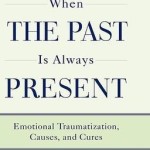
 Ruden, R.A. (2011) When the Past is Always Present. 132 New York, NY: Routledge. 132 pages. ISBN:978-0-415-87564-6
Ruden, R.A. (2011) When the Past is Always Present. 132 New York, NY: Routledge. 132 pages. ISBN:978-0-415-87564-6
Reviewed by: Alexa D’Angelo, Hunter College
Ronald A. Ruden offers biological explanations and therapeutic techniques for the treatment of traumatization in When the Past is Always Present. He expounds at length on the biological mechanisms that occur during the process of trauma encoding, and later offers techniques to reverse the trauma and consequently bring balance to the brain and emotions. This book is intended for therapists, as well as those suffering from trauma and looking to self-administer helpful, healing techniques.
Ruden begins his book by introducing a third pillar to the already existing psychological treatments: psychotherapy, and psychopharmacology. He proposes psychosensory therapy, as a method for treating traumatization (5). Emphasizing the utilization of human touch, psychosensory therapy uses the emotion linked to the trauma, in conjunction with a strategic application of human touch, to reverse the cognitive imbalance resulting from the traumatization (5). Psychosensory techniques treat the traumatization as a mind-body interaction rather than solely focusing on the mind and brain.
Ruden proposes “Havening” as a method to treat traumatization through the utilization of human touch and the re-exposure of a traumatically encoded emotion (95). This combination can help alleviate the trauma as it exists as an imbalance in the brain. Ruden explains the biological process of the reversal of the traumatization in Chapter Eight. Chapter Eight also includes a helpful guide to Havening, which could be easily applied by a therapist (109). However, if one is reading the book in the hopes of “Self-Havening”, Ruden has supplied a guide that does not require the assistance of another individual (113). These tools could prove very useful for an individual struggling with a traumatizing event.
Ruden fills the remainder of the book with anecdotal examples of trauma, along with several appendices intended to guide therapists though their use of psychosensory trauma techniques. Ruden’s appendices offer suggestions for therapists, along with circumstantial specifics relative to differing issues a therapist may be working with.
When the Past is Always Present offers an extensive amount of information on the causation and manifestation of trauma. Ruden has created a technical guide to understanding the mechanisms of trauma, along with a manual of psychosensory techniques. Through his many examples and step-by step instructions, one can feasibly perform psychosensory techniques on his/her patients, as well as self-administered havening techniques. Ruden’s text could also prove useful as a resource for students looking for a comprehensive explanation of the biological mechanisms that accompany an encoded trauma, as well as a window into possible trauma treatments.
Ruden, R.A. (2011) When the Past is Always Present. New York, NY: Routledge.
ISBN: 978-0-415-87564-6
Hardcover, 210pp. Index Included.
